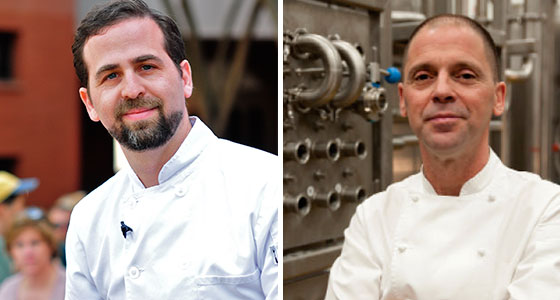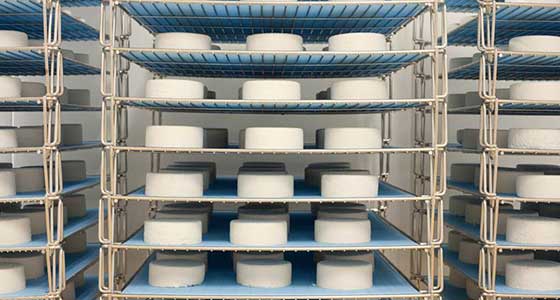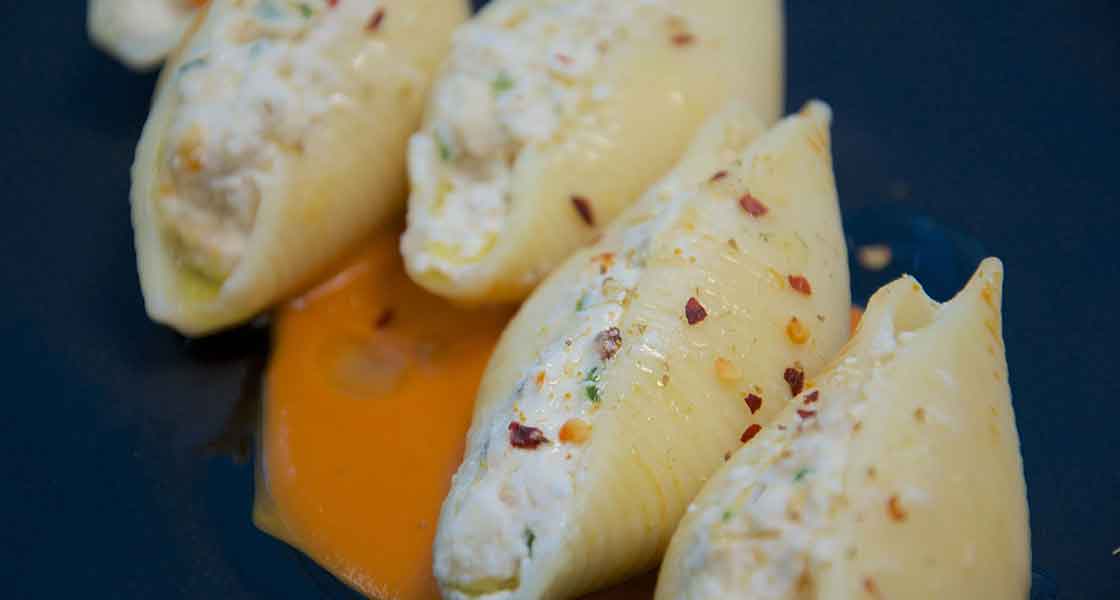Kite Hill: Balancing Innovation & Tradition
CULINARY POINT OF VIEW
What does a celebrity vegan chef have in common with a cheese-making instructor from the Le Cordon Bleu? They work together to create almond milk-based cheeses that follow the time-honored techniques of artisanal dairy cheese-making. Chef/Product Developer Monte Casino and Chef Tal Ronnen, both co-founders of Kite Hill, work with the other team members to combine the best ingredients, naturally occurring enzymes, and a specially developed lactose-free culture to slowly age their cheese using traditional French equipment. Their goal is to create cheeses that rival the best artisan dairy cheeses and entice the full range of food lovers: omnivores, vegetarians, and vegans alike.

From left: Tal Ronnen and Monte Casino (© Liza Gershman)
Kelly Hensel: How did you become co-founders of Kite Hill?
Tal Ronnen: I met Monte when I was doing workshops at Le Cordon Bleu’s campuses in 2009. One of them was in Boston where Monte was teaching artisan cheese-making, charcuterie, and all these old-world classes. I sat in on one of his classes and we got to talking about making cheese using traditional techniques but not with dairy milk.
Around the same time I met Pat Brown, a biochemistry professor at Stanford, who was working on making cheese using different milks. We all started working on nut milk-based cheese and Monte came up a great prototype that really got the company off the ground. We then teamed up with Cathy Strange, the global cheese buyer for Whole Foods. Whole Foods really has one of the biggest cheese counters of any store and we wanted to get her expertise and really her approval of what we were doing.
Monte Casino: When Tal and I were talking about forming the company, I was hesitant because I was very happy where I was at in the restaurant industry. But Tal told me, “In the restaurant industry, you can affect 100–200 people every night, but in the retail industry you can affect thousands of lives.” It made it much more meaningful to me. I moved out to California in July of 2011 and we’ve been an LLC ever since then.
Hensel: What are your respective responsibilities for Kite Hill?
Ronnen: Monte really runs the show. He’s the cheesemaker and has a kitchen attached to the manufacturing facility. He’s churning out new ideas almost weekly. I am not there on a day-to-day basis—I’m based in Los Angeles, but I talk to the team often and travel for the company quite a bit.
Casino: I do a lot of conceptual work because we are always looking to the future. I am always asking myself, “What can I do to make a new cheese?” I also spend a lot of time sourcing. We have to source a lot of enzymes and so I am always exploring new enzymes to see what kind of texture they can offer. At times, I may be working on three or four different cheeses at once. We’ve been working on a feta for about a year now and really focusing on how to get it to have a two-year shelf life.

© Liza Gershman
Hensel: Why did you choose to use almond milk and not another nut-based milk?
Ronnen: Almonds contain protein which you need to form a curd and make cheese. Pat [Brown] found that the protein and fat ratio in almonds works particularly well for forming a curd and making cheese without the use of gums and starches. Also, we can locally source them. Our almonds come from a place just a couple hours away from our manufacturing facility.
A lot of nut milk-based cheeses use cashews. They grind the cashews with very little water and press them into a mold to make “cheese.” It ends up having a texture more like a hummus, while our cheese is a creamy white cheese.
Hensel: Currently, Kite Hill has four types of cheese—original, ripened, cream cheese, and ricotta. What are you and the team working on developing next?
Ronnen: We are actually working on a line of almond milk-based yogurt using specific cultures to give it the same profile as other dairy yogurts. We have found that having more everyday products—like cream cheese and yogurt—is good for the business because people are consuming these types of products more often than they might our blocks of cheese.
We also have ricotta that we ship in bulk to Whole Foods stores and they hand pack it into smaller containers. But we will have a retail package of the ricotta that will begin shipping nationally in May. The ricotta is great because you can cook with it, making it more of an everyday item. At my restaurant—Crossroads in Los Angeles—we use it in a stuffed pasta dish and also in a cheesecake dessert.

© Liza Gershman
Cauliflower, Butter Bean & Ricotta Stuffed Shells
Yields 12 portions from a 2 inch full hotel pan
1 bag of extra large shells
3 lbs of Kite Hill Firm Ricotta
1 lb rinsed canned butter beans
1 – 26 oz can of crushed tomatoes
8 oz cauliflower florets
½ cup olive oil
4 oz almond milk (white version, works best to keep white color of ricotta)
3 oz yellow onion
2 oz fresh garlic finely diced
2 oz fresh chopped parsley
2 oz fresh chopped sage
1 tsp finely diced shallot
Tomato Sauce
Sweat 2 oz. chopped shallot with 2 oz of chopped garlic in 2 tbsp of olive oil. Add 1 can of crushed tomatoes, simmer for 20 min and blend until smooth.
Roasted Cauliflower
In a med. bowl add 8 oz of cauliflower florets, 3 oz of chopped yellow onion and 1/8 cup of olive oil. Transfer to a large sheet tray and roast in 350°F oven till tender. Combine roasted cauliflower and onion with 1 lb of rinsed butter beans and heat on low for 5 min. Blend, then let cool before adding 3 lbs of ricotta with 2 oz of chopped parsley, 2 oz fresh sage and salt and pepper.
Stuffed Shells Application:
- Put seasoned ricotta mixture in a pastry bag, pipe mixture into blanched shells.
- Line bottom of pan with tomato sauce, add 50 stuffed shells.
- Cover and bake at 325°F for 20 min.


